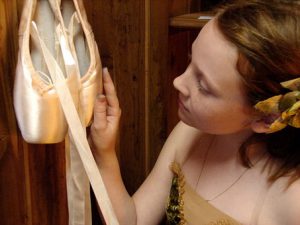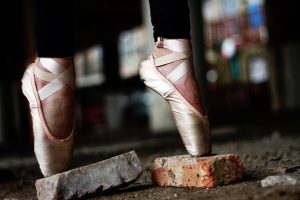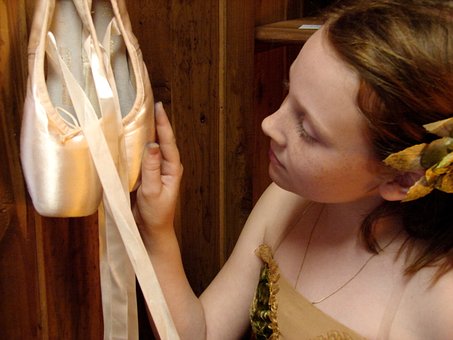
Getting your first pair of pointe shoes is an exciting time in any ballet dancers life, so in this post, I have decided to write a pointe shoe fitting guide to make your first experience on pointe as comfortable as possible for you.
If you were to dissect ballet down to a single, iconic image, it would most probably be the pointe shoe.
As young children, we always fantasized about dancing on our toes, but we knew that the pointe shoe was only for serious dancers and is the first step towards being a real ballerina.
It is the ultimate achievement in ballet to progress to pointe work, but be warned, the first time you go up onto those pointes, those tears of happiness could turn into tears of pain, but it is a pain that most dancers, in time, get used to.
When Is The Best Time To Start Dancing On Pointe?
As a rough guide, the absolute earliest age to go on point is 11, although 12 or 13 is more common and probably safer.
Going on pointe should be at the onset of puberty and never before. The dancer should have at least four years of ballet training under her belt, and if she is only taking one ballet class a week, four years then isn’t enough.
Starting later rather than earlier is always best because, in young bodies, the bones are yet to harden, and starting too early can cause enormous damage to both the bone formation and the growth plates in the feet.
Remember that there is absolutely no reason at all not to start later.
A good test for readiness is to do a series of releves devant on demi-pointe. Try sixteen on one leg in the center holding the body with balance and security. When you can do this well on both legs, you are probably ready for pointe work.
Remember that the shoes don’t do the dancing, the dancer does, and the dancer needs to be prepared both mentally and physically. Sometimes children are ready physically but don’t have the concentration to do justice to their pointe training.
What Is The Ideal Foot For Pointe Work?
The ideal foot for pointe work is said to have the first three toes the same length, but that doesn’t happen very often as it is the luck of the genetic draw.
 Any dancer can work on strengthening their feet with tools like resistance bands and working against your own body weight.
Any dancer can work on strengthening their feet with tools like resistance bands and working against your own body weight.
Feet with high arches, although very pretty, will need extra strengthening, as they tend to be the weaker type of foot.
Remember that it is not only the strength of the foot that is important but the body as a whole. A dancer on pointe has to be especially strong in the core.
A foot that has an arch that is neither too high or too flat is usually ideal.
Pointe Shoe Fitting Guide
Now the monumental occasion has arrived where you will go and buy your pointe shoes, armed of course with your pointe shoe fitting guide, it can still be overwhelming.
Before you go for your first pointe shoe fitting, cut your toenails short.
Make yourself some notes from this pointe shoe fitting guide and use it as a reference. If you don’t write it down, you won’t remember.
It can be confusing going up on pointe for the first time. You are not sure how you are supposed to feel when you go up on pointe – is it supposed to be so sore?
The most important advice I can give is to get a professional pointe shoe fitter. Never buy your first pair of pointe shoes online without trying them first.
Never be scared to ask questions.
Try as many pairs as you can in different brands so that you can feel the difference.
You should be able to plie in your pointe shoes with the big toe just touching the end of the shoe. The pointe shoe should feel like a tight slightly suffocating hug around your forefoot. The toes should still be able to spread.
When you rise on your pointe, you should feel your big toe make contact with the floor, but also the feeling that your pointe shoes are supporting your foot evenly across the whole foot.
The toes should lie flat and not be clenched within the shoe.
The vamp should cover the toes, so in other words, no toe cleavage.
The shoe must be snug across the knuckle of the toe, but not squeeze it so much as to inhibit movement.
When on pointe, there is likely to be a bit of spare fabric at the heel – that’s ok.
Make sure that the shank of the shoe lines up straight with the sole of the foot. If you find it twisting to the side, then you probably have the wrong width of shoe.
When you get it right, the shoe actually becomes an extension of the body.
The most important part of this pointe shoe fitting guide is that you should not rush your fitting. Pointe shoes are an investment and you need to be absolutely sure that they are right for you before you purchase them.
Breaking Those Shoes In
While most pointe shoes are still made with traditional materials, there have been many advances in technology over the past few years.
 Some shoes now use more flexible polymer in the shank and box and even shock-absorbing cushioning.
Some shoes now use more flexible polymer in the shank and box and even shock-absorbing cushioning.
Even the more traditional shoes have changed gradually to suit the more modern dancer. They have become softer and don’t need as much breaking in as they used to.
No more is bashing and hammering required, and you will just need the heat and the sweat of your feet to do most of the work.
The prep work you will still need to do is sew on your ribbons and maybe elastic. Make sure you find out from your fitter just where the best place is to attach them and at what angles for the best fit.
In the past, we had to darn the platform for extra grip, but nowadays you can also purchase small suede patches which you can glue to the shoe – much easier.
Prepping Those Feet
To prep our feet, we were told to dip our toes in surgical spirits to harden them, but nowadays, it is suggested that moisturizing the feet works better so that your skin stays more elastic.
Lambswool is an old favourite, but now dancers tend to tape their toes to stop the skin from splitting. There are also gel toe-spacers available to keep toes aligned and avoid bunions.
Silicon pads to slip over the toes also work a treat. The less bulky the better, or you won’t be able to articulate the joints.
Start Slowly
Of course, now that you have your shoes, you are probably rearing to go, but remember that pointe work must start slowly and gradually – maybe ten minutes at the end of class.
Practise walking in your shoes so that you get comfortable in them, then walk and run in three-quarter pointe, until those shoes feel like extensions of your feet. Click here for some more tips on starting pointe work.
With good fitting and good teaching, pointe work will become a joy to do.
If you have any more points to add to this pointe shoe fitting guide, please feel free to comment below.

